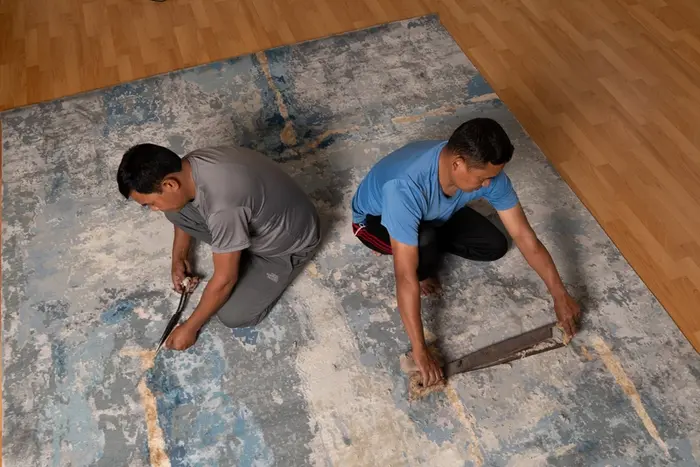When you walk across a high-quality rug, you’re stepping on more than just fabric — you’re stepping on precision, discipline, and tradition. At NP Rugs, uniform knot density is not just a technical benchmark; it’s a reflection of artisan excellence and mechanical precision.
In this article, we unravel how rug tension and weave accuracy are maintained at NP Rugs, ensuring every handcrafted piece is consistent, strong, and visually flawless.
Why Knot Density Matters in Rug Quality
Knot density, measured in knots per square inch (KPSI), is a critical indicator of a rug’s quality, durability, and value. A high-density rug often means:
- Sharper design clarity
- Increased durability
- More labor-intensive craftsmanship
According to the International Rug Guide, rugs with over 120 KPSI are considered high-end, with some reaching up to 1000 KPSI in premium Persian styles. At NP Rugs, custom designs usually range from 80 to 250 KPSI, depending on the material and client specifications.
But to keep the knot count uniform across a large rug surface — sometimes over 300 square feet — tension control and weave accuracy must be nearly perfect.
The Secret Is in the Tension: Setting the Foundation Right
Maintaining consistent tension on the loom is the backbone of uniform weaving.
NP Rugs’ Approach:
- Custom Loom Calibration: Each loom is carefully tuned before weaving begins. Learn more about this process in Why Rug Loom Setup Determines Quality.
- Tension Bars & Weighted Systems: Adjustable tension bars are used to maintain a balanced grip across the warp threads (vertical yarns).
- Daily Monitoring: Weavers use calibrated gauges and visual inspection to check for sagging or overtightness.
If the tension is uneven, the rug may warp, buckle, or develop waves — all signs of inconsistency. NP Rugs’ artisan team mitigates this through frequent checks and in-house training on loom management.
“We treat every loom like an instrument. If the tension is off, the music isn’t right,” says Bikash, a master weaver featured in Meet the Artisans of NP Rugs.
Precision in Weaving: One Knot at a Time
Once the tension is set, precision weaving comes into play. NP Rugs uses detailed graph maps and design blueprints to guide every knot.
Techniques Used:
- Graph-Based Weaving: Weavers follow high-resolution graphs that translate design pixels into knot patterns. These are especially crucial for custom projects — see Rug Prototypes & Sampling.
- Supervised Sectional Weaving: Large rugs are divided into zones, and each section is woven under a dedicated supervisor to ensure knot alignment.
- Periodic Audits: Every 6 inches of weaving is measured using special combs and tension tools.
This accuracy allows NP Rugs to deliver results that match the original renderings from their rug design studio without visual distortion.
The Role of Artisan Skill and Experience
At the heart of all this precision are the hands behind the loom. NP Rugs invests heavily in artisan development through:
- Skill workshops
- On-the-job mentorship
- Internal quality scoring systems
Many of NP Rugs’ artisans have been working for 10–30 years, with some able to tie up to 10,000 knots per day. Their ability to maintain tension by “feel” — developed over decades — is irreplaceable.
To explore their stories, visit Meet the Artisans of NP Rugs.
Final Check: Quality Audits and Surface Consistency
After weaving, rugs go through a rigorous quality assurance process using a checklist that includes:
- Knot density sampling
- Straight edge measurements
- Symmetry comparison with design maps
Only rugs that meet these standards proceed to washing and finishing, where tension and knot integrity are re-verified post-wash to ensure no looseness or shrinkage has occurred.
Tradition + Data: Weaving Intelligence into Craft
While NP Rugs preserves traditional methods, they also integrate modern analytics to improve consistency. Their system tracks:
- Knot variation reports
- Loom-specific quality issues
- Weaver performance data
This hybrid approach, detailed in Weaving Intelligence: How NP Rugs Balances Traditional Methods with Modern Production Insights, enables ongoing refinement without losing the human touch.
Key Takeaways: What Rug Buyers Should Know
- Uniform knot density = consistent quality — a key marker for premium rugs.
- Tension control is essential — it starts at the loom and is maintained throughout.
- Artisans make the difference — their experience ensures visual precision and durability.
- NP Rugs blends craft with innovation — offering both heritage and reliability.
Whether you’re an interior designer, retailer, or homeowner, understanding these behind-the-scenes practices gives you confidence that each NP Rug is not only beautiful but built to last.
To understand more about how NP Rugs approaches every step of the manufacturing journey, explore How Rugs Are Made: A Look Inside NP Rugs’ Manufacturing Process and The Dye Master’s Craft.

